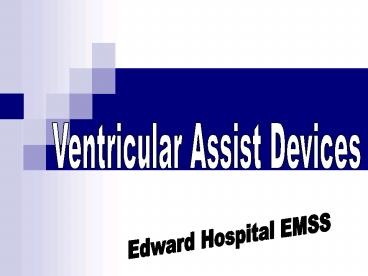Ventricular Assist Devices Zoll LifeVest External Defibrillator - PowerPoint PPT Presentation
1 / 18
Title:
Ventricular Assist Devices Zoll LifeVest External Defibrillator
Description:
* Ventricular Assist Devices A Ventricular assist device, or VAD, is a mechanical circulatory device that is used to partially or completely replace the function of a ... – PowerPoint PPT presentation
Number of Views:292
Avg rating:3.0/5.0
Title: Ventricular Assist Devices Zoll LifeVest External Defibrillator
1
Ventricular Assist Devices
Edward Hospital EMSS
2
- Ventricular Assist Devices
A Ventricular assist device, or VAD, is a
mechanical circulatory device that is used to
partially or completely replace the function of a
failing heart.
3
Pulsatile Vs. Non-Pulsatile
- Pulsatile
- Older first generation models
- Non-Pulsatile
- Second / Third Generation Models (Most Common)
4
VADs
- Ventricular Assist Devices
- LVAD
- RVAD
- Bi-Vad
5
VAD
6
Who uses VADs?
- 7318 people were waiting for a heart
- 2210 received one
- 623 died waiting
- 1200-1500 VAD implanted in 2008
7
Who uses VADs?
- Bridge to Transplant
- Bridge to Recovery
- Destination Therapy
8
Field Considerations
- Treat patient as an adult with special health
care needs. - Find family member or aide who is familiar with
equipment - Always treat the patient!
9
Field Considerations
- If patient has an LVAD and it is working
properly, it is providing most of the patient's
cardiac output. - Patients EKG rate may not equal pulse rate.
Utilize the EKG rate for determining a pulse as
the VAD pump is continuous. - A doppler is required to obtain an accurate BP.
- Utilize skin parameters and mental status to
assess perfusion.
10
Field Considerations
- All VADs are dependent on adequate preload in
order to maintain proper functioning - Pump can cavitate if there is a decreased
preload - Volume resuscitation in an unstable VAD patient
is the first line of therapy before vasopressors.
When in doubt Give Fluids!!!!
11
Field Considerations
- Nitrates can be detrimental to a VAD patient
because of the reduction in preload - Results in decreased pump efficiency
- Consult with medical control before administering
nitrates per protocol - Initiate IV therapy with all VAD patients if
possible - Think FLUIDS!!!
12
Field Considerations
- A patient can be in a lethal arrhythmia and be
asymptomatic. Treat the patient not the monitor. - Do not cardiovert/defib unless the patient is
unstable with the arrhythmia. - If you must cardiovert/defib, place pads anterior
and posterior to avoid potential damage to
equipment.
13
Field Considerations
- Chest compressions are utilized as a last resort
only. If VAD device not functioning and patient
obviously dead, initiate compressions.
14
Field Considerations
- Trauma Patients
- Avoid cutting driveline for VAD device when
exposing. - Avoid pinching driveline under backboard/patient.
- Some VADs have DC power supply for vehicles.
Ensure that it is not plugged in prior to
removing patient from car.
15
- VAD Driveline
- Cable that runs from VAD controller to the
internal pump.
16
Transport Consideration
- If able, transport the patient with any other
pertinent equipment needed for the VAD pump. - Batteries
- Charging unit
- Base Station
17
Questions???
18
Sources
- http//www.mayoclinic.org/heart-transplant/vad.htm
l - http//www.medicinenet.com/left_ventricular_assist
_device_lvad/page2.htm - www.mfri.org/dom/Drill_pdf/DM_0911.ppt
- http//www.uchospitals.edu/specialties/heart/servi
ces/heart-failure/assist-devices.html

